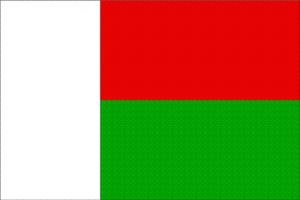Language/Plateau-malagasy/Grammar/Adjectives
Hi Plateau Malagasy learners! 😊
In this lesson, we will explore adjectives in Plateau Malagasy. Adjectives are essential in any language as they describe nouns and pronouns.
Consider broadening your understanding by checking out these related lessons: Pronouns, Plateau Malagasy Grammar → Prepositions and Conjunctions ..., Conditional Mood & Comparative and Superlative Adjectives.
Adjective Basics[edit | edit source]
In Plateau Malagasy, adjectives usually come after the noun they describe. For example:
| Plateau Malagasy | Pronunciation | English |
|---|---|---|
| akoho madio | əˈkʷuhʷ ˈmadʲu | white rooster |
In the example above, "madio" is the adjective that describes the noun "akoho" (rooster). In this case, we use an adjective that denotes color.
Another way to use adjectives in Plateau Malagasy is to use it with personal pronouns. For instance:
| Plateau Malagasy | Pronunciation | English |
|---|---|---|
| aho malala | əˈhu maˈlølə | I am tired |
In this example, the adjective "malala" describes the personal pronoun "aho" (I).
It is also important to know that adjectives don't change based on gender, number, or tense. They remain the same in all circumstances.
Common Adjectives[edit | edit source]
Now, let's look at some commonly used adjectives in Plateau Malagasy:
| Plateau Malagasy | Pronunciation | English |
|---|---|---|
| madio | ˈmadʲu | white |
| manga | ˈmaŋɡə | big |
| kely | ˈkeːlʲ | small |
| mamy | ˈmamʲ | tasty |
| malala | maˈlølə | tired |
In Plateau Malagasy, it is common to use adjectives when talking about food, like in the example above where "mamy" is used to describe food that is tasty.
Comparison of Adjectives[edit | edit source]
In Plateau Malagasy, adjectives can be compared by using the words "be sady" for comparative form, and "be eo" for superlative form. Here's an example:
| Plateau Malagasy | Pronunciation | English |
|---|---|---|
| tokan-trano be sady manga | toˈkãn ˈt͡rano be ˈsadz ˈmaŋɡə | This house is bigger than that one |
In this example, the comparative form "be sady" is used to compare the two houses in terms of size.
For superlative form, "be eo" is used. For example:
| Plateau Malagasy | Pronunciation | English |
|---|---|---|
| ny ankamaroan'ny olona dia malala be eo | nə‿ʔaŋkəməˈrwanˈ(ny) ɔˈluhʷna dʲa maˈløla be ˈew | Most people are tired |
In this example, the superlative form "be eo" is used to describe the most tired people.
Dialogue[edit | edit source]
To see how adjectives are used in context, here's a dialogue between two people:
- Person 1: Tsara fantatro aho fa izay lehibe indrindra eto Andriana. (I know very well that the biggest one here is Andriana.)
- Person 2: Eny, izay no olon-tiany be sady kely indrindra. (Yes, that is her youngest child, who is the smallest.)
Practice Exercise[edit | edit source]
To practice using adjectives in Plateau Malagasy, translate the following English sentence:
"The red car is faster than the blue one."
Conclusion[edit | edit source]
In this lesson, we have learned about adjectives in Plateau Malagasy, how to use them with nouns and pronouns, and common adjectives you might encounter. Don't forget to use Find native speakers and ask them any questions if you have any further doubts. Besides, continue learning Plateau Malagasy at PolyglotClub.com! 😎
➡ If you have any questions, please ask them in the comments section below.
➡ Feel free to edit this wiki page if you think it can be improved. 😎
Well done on mastering this lesson! Don't miss these related pages to expand your knowledge: How to Use "Be", Say Hello and Greetings in Plateau Malagasy, Nouns and Gender & 0 to A1 Course.

